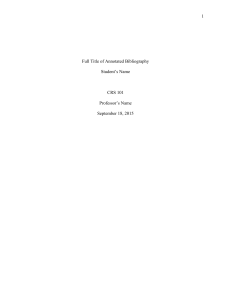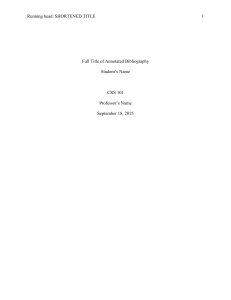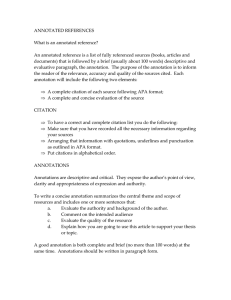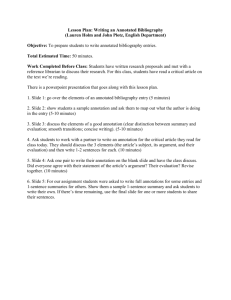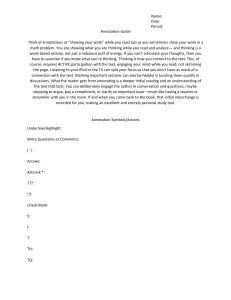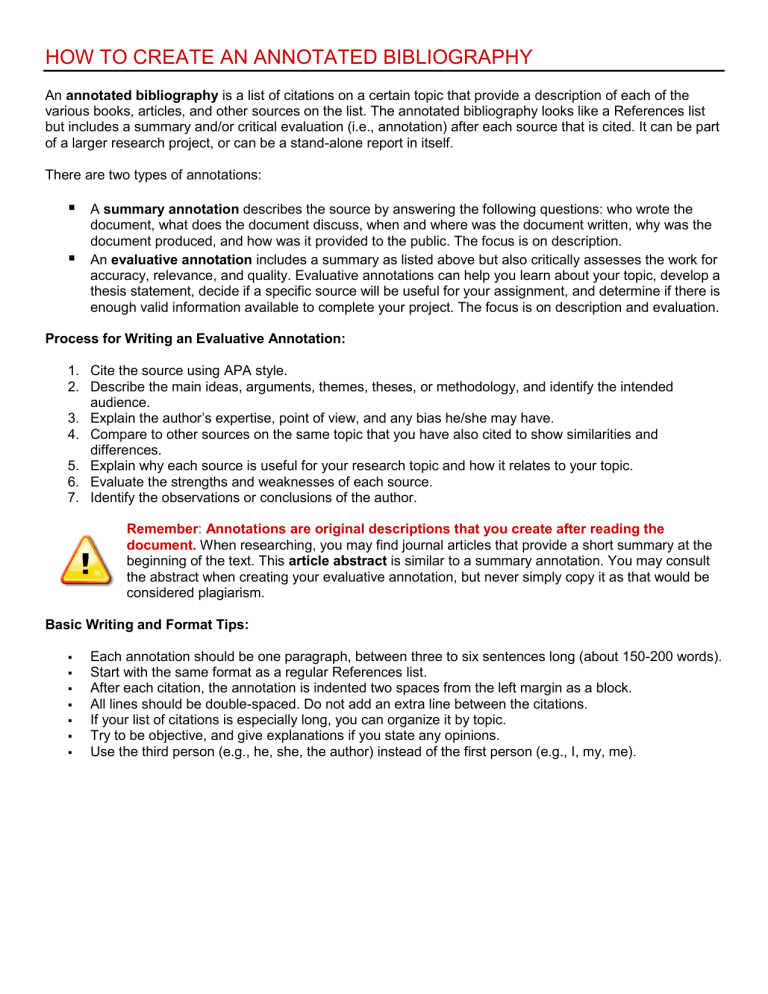
HOW TO CREATE AN ANNOTATED BIBLIOGRAPHY An annotated bibliography is a list of citations on a certain topic that provide a description of each of the various books, articles, and other sources on the list. The annotated bibliography looks like a References list but includes a summary and/or critical evaluation (i.e., annotation) after each source that is cited. It can be part of a larger research project, or can be a stand-alone report in itself. There are two types of annotations: A summary annotation describes the source by answering the following questions: who wrote the document, what does the document discuss, when and where was the document written, why was the document produced, and how was it provided to the public. The focus is on description. An evaluative annotation includes a summary as listed above but also critically assesses the work for accuracy, relevance, and quality. Evaluative annotations can help you learn about your topic, develop a thesis statement, decide if a specific source will be useful for your assignment, and determine if there is enough valid information available to complete your project. The focus is on description and evaluation. Process for Writing an Evaluative Annotation: 1. Cite the source using APA style. 2. Describe the main ideas, arguments, themes, theses, or methodology, and identify the intended audience. 3. Explain the author’s expertise, point of view, and any bias he/she may have. 4. Compare to other sources on the same topic that you have also cited to show similarities and differences. 5. Explain why each source is useful for your research topic and how it relates to your topic. 6. Evaluate the strengths and weaknesses of each source. 7. Identify the observations or conclusions of the author. Remember: Annotations are original descriptions that you create after reading the document. When researching, you may find journal articles that provide a short summary at the beginning of the text. This article abstract is similar to a summary annotation. You may consult the abstract when creating your evaluative annotation, but never simply copy it as that would be considered plagiarism. Basic Writing and Format Tips: Each annotation should be one paragraph, between three to six sentences long (about 150-200 words). Start with the same format as a regular References list. After each citation, the annotation is indented two spaces from the left margin as a block. All lines should be double-spaced. Do not add an extra line between the citations. If your list of citations is especially long, you can organize it by topic. Try to be objective, and give explanations if you state any opinions. Use the third person (e.g., he, she, the author) instead of the first person (e.g., I, my, me). Example – Summary Annotation Maak, T. (2007). Responsible leadership, stakeholder engagement, and the emergence of social capital. Journal of Business Ethics, 74, 329-343. doi:10.1007/s10551-007-9510-5 This article focuses on the role of social capital in responsible leadership. It looks at both the social networks that a leader builds within an organisation, and the links that a leader creates with external stakeholders. Maak’s main aim with this article seems to be to persuade people of the importance of continued research into the abilities that a leader requires and how they can be acquired. The underlined words below show what has been added to the summary annotation to make it an evaluative annotation. Example – Evaluative Annotation Maak, T. (2007). Responsible leadership, stakeholder engagement, and the emergence of social capital. Journal of Business Ethics, 74, 329-343. doi:10.1007/s10551-007-9510-5 This article focuses on the role of social capital in responsible leadership. It looks at both the social networks that a leader builds within an organisation, and the links that a leader creates with external stakeholders. Maak’s main aim with this article seems to be to persuade people of the importance of continued research into the abilities that a leader requires and how they can be acquired. The focus on the world of multinational business means that for readers outside this world many of the conclusions seem rather obvious (be part of the solution not part of the problem).In spite of this, the article provides useful background information on the topic of responsible leadership and definitions of social capital which are relevant to an analysis of a public servant. Memorial University Libraries. (2008). How to write annotated bibliographies. Retrieved November 13, 2013, from http://www.library.mun.ca/guides/howto/annotated_bibl.php
